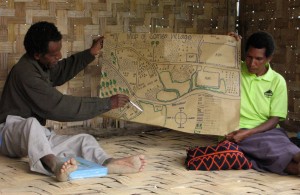Micro Power Feasibility Site Assessment
Micro Power Feasibility Site Assessment in Eastern Highlands Province, Papua New Guinea
By:
Tom MacKay, P. Eng., CoBiz Group Ltd.
Alan Scheibner, P. Ag., CoBiz Group Ltd.
 Abstract
Abstract
Blue Water Energy Partnership and Blue Ocean Energy Ltd., of Calgary, Alberta, Canada, predecessor organizations to CoBiz Group Ltd., performed an investigation of remote community micro-power project feasibility in Eastern Highland Province, Papua New Guinea during June, 2011. Purpose was to assess candidate sites and identify the appropriate run-of-river technologies for each. A key objective was to determine the suitability of Canadian micro-power technology in semi-tropical and tropical environments. It was concluded that application of particular run-of-river technologies is dependent on water body characteristics, as well as local community needs.
Introduction
The Eastern Highlands Province, Papua New Guinea, is an isolated region, challenged by technical, service, economic, and logistical restrictions, which hinder the development of affordable electrical power to a large percentage of the population of this area.
During June, 2011, the principals of Blue Water Energy Partnership traveled to the Eastern Highlands Province to meet local Government officials, business owners, and community groups to understand the needs and challenges of providing and operating local community-based micro-hydro power solutions for remote communities. During the time in-country a number of meetings were held from the Governor level to potential individual power users. A significant amount of time was spent visiting potential river and stream sites at several locales with Eastern Highlands Province.
Meetings
Three meetings were held with Malcolm Smith-Kela, Governor of Eastern Highlands Province, regarding overviews of the proposed site visits and objectives with respect to appropriate technology investigations, status updates of field investigations, and to discuss identified power implementation opportunities.
A meeting was held with officials of the Town of Goroka, Eastern Highlands, regarding a potential power generation demonstration project within the town utilizing the town’s water supply channel.
A meeting was held with a local engineer to discuss his involvement as a potential R&D partner in the development of micro-power technology appropriate to individual sites within the Province. A meeting was held with a local power technician who provides power system maintenance to a group of churches within the Eastern Highlands. The purpose of the meeting was to assess his interest and capabilities in providing ongoing maintenance support and expertise to installed power projects. A meetings was also held with a construction company capable of installing a small power project.
Power Project Design Issues
Prior to the country visit, Blue Water had identified Canadian-developed encurrent technology (5 – 25 KW) that might be appropriate for micro-hydro power run-of-river projects in Papua New Guinea. The power units investigated consisted of turbines mounted on a pontoon type of delivery platform that float on the surface of a moving water body and are anchored in place.
Although challenged by road conditions, the field investigations met or exceeded expectations. Transportation and a senior resource person were provided by the Governor. This resource person also provided community contacts which were important in assisting with site investigations. Seven days were spent undertaking various field investigations in the Asoro, Bena, Gumuni, Kwongi, Segoia, Kainantu, Alyura, and Duna areas of Eastern Highlands Province. Two other areas of interest, Marawak and Kivrinka, were not visited due to inaccessibility during the time in country.
As a result of the field investigations and meetings with knowledgeable technical people and local residents, significant challenges were identified with respect to implementing encurrent technology in the upper regions of river systems in a tropical or semi-tropical environment. Key challenges included (1) significant seasonal variations in water level, (2) security of the system from floodwater and debris damage, and (3) personal safety of river users in the vicinity of the equipment.
To overcome these challenges it was determined that further R&D is required to support a channel type of encurrent turbine fixture, as opposed to installation in a river or stream subject to flooding. The R&D would focus on turbine platform design that would result in the placement of the turbine over a man-made channel with flow control features.
One potential site was identified on the Asaro River near the Kwongi Mission. There is a potential to construct a river side channel to divert and control water levels and placement of one or more stationary platforms for encurrent-generated power.
Another preliminary conclusion from the various site visits was that, in many cases, turbine-derived power generation from penstock-delivered water, was the most appropriate type of power generation. However, problems with slope stability in the steep terrain of several of the areas necessitate geotechnical investigations prior to construction.
Local Community Considerations
One of the main conclusions of the feasibility study was the identification of community ownership and on-going maintenance as a critical component in the viability of a power project. During the site visits, Blue Water met with community elders and church leaders, as well as with independent local business people residing near individual potential power sites. Papua New Guinea faces challenges related to tribal jealousy issues, limited economic resources, and lack of technically trained personnel to operate power systems. A business model is required that takes these issues into account to prevent early failure of a project. The potential involvement of women’s groups in the ownership and management of a power project was identified as a way to overcome some of these challenges by involving more than one tribe or village and to facilitate dispersion of economic gains from the provision of electric power from the project.
In terms of the commercialization component of a power installation project, a concern was whether an economic model to purchase and sustain the power generation equipment could be achieved. After several discussions with Government officials, community leaders, and other individuals, the use of generated power to charge cell phone batteries was identified. More work is required to develop an economic model to serve this need.
Next Steps
As a result of this preliminary assessment of micro-power project issues in the eastern Highlands Province, individual sites should be further investigated with respect to specific characteristics to determine the most appropriate technology to be implemented. It is likely that further engineering design work will be required in the case of encurrent technology to provide a solution capable of handling the operating challenges at many of the field sites visited. As well, attention must be given to the design of electrical controls to provide ease of operation and maintenance. A feasibility study, incorporating technical design, expected capital and operating costs, funding sources, ownership, and end users has to be undertaken.
Conclusions
The Eastern Highlands Province of Papua New Guinea has a large number of opportunities for the implementation of micro-hydro power projects to serve remote communities. Technical challenges related to stream flow variability, slope stability, and installation and maintenance costs necessitate a careful assessment of the appropriate technology for each site considered. Community involvement, including site selection, project ownership and maintenance, and power end-user arrangements is critical.
